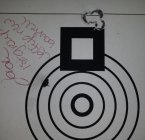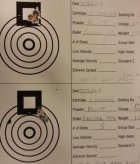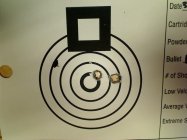Just an update in case another soul wanders on this post in search of answers.
I have recieved a lot of excellent advise from forum members through a great phone call and several PM's from members with a lot of Dasher experience. What I have learned so far is that even though my first jam and shoot fireforming load produce groups that were acceptable for me to shoot in a local F class match, I was making brass that would be perpetually short and have widely variable volumes for the second firing. (Thanks dmoran and johara1) In short, I would add to my barrel's round count by as many cases as I wanted to form with rounds that would probably not perform as well as the first firing because of the now variable case volumes.
Aside from the inconsistent shoulder definition, my main fireforming problem has been the overall blow length. My first two sessions with Jam method and false shoulder method resulted in an average case length that averaged in the neighborhood of 1.532". Surprisingly both methods have very similar overall lengths despite the marked difference in case definition and the switch from RL-15 to a stiffer charge of Varget. (recommended by both Johara1 and Killshot)
What I think I have learned so far...
1- The Dasher just wants to shoot. Through the first 40 rounds of fire forming this round has agg'd .355". If this was a straight 6BR I would not be all that impressed, but for fireforming loads this kind of wows me.
2- Use a fairly stiff load to ensure that you get uniform results. If not, you will learn nothing from the second firing.
3- By the luck of actually loading the 1st case I used to set up the false shoulder die which had the false sholder set back a few thousandths from all of the others and observing that its formed length is actually .006" longer than any of the others, I feel that setting the shoulder up for an extremely hard bolt close, like I did, actually impedes the neck forming process. My reasoning is that both methods I tried used the same tight bushing and the bullets jammed .020" into the lands. I had a lighter powder charge for the jam and shoot session which could account for the similarities in blow lengths between the two methods, however the only variable that changed in the second session was the set back on the false shoulder on one round , and I got very repeatable results with 19 of the 20 rounds fired. Granted, one round could be an anomaly, but the difference was drastic and like the heading says, this is what I "think" I have learned.
Unconfirmed theories?...
Regardless of actual pressure does a fuller case of powder form better? I have no actual data other than feel and looking at the usual pressure signs, but reading about people filling cases with cream of wheat, the empirical observations of Killshot between rl-15 and varget, and my VERY limited testing, I'm leaning towards a yes answer. Just food for thought.
What is next?...
On the advise of dmoran and johara1 I need to get the blow length right the first time because once they are short, they will always be short.
What I did tonight was remove the firing pin assembly from the bolt, ( I have no ejector, but I would have removed it if it was present) and set the false shoulder up so that I could lightly feel the tension when closing the bolt but not have the 10+ lbs of force required to chamber that I had on the second session. I am hopefull that this new setup will allow me to start seeing some control over blow length based on the powder charge.
Other than figuring out the blow length, I think I have it wired and can't wait to start actually working up loads.
Jeff















